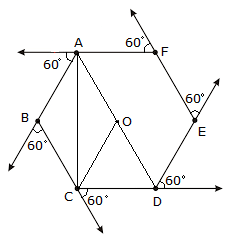On an open ground, a motorist follows a track that turns to his left by an angle of 600 after every 500 m. Starting from a given turn, specify the displacement of the motorist at the third, sixth and eighth turn. Compare the magnitude of the displacement with the total path length covered by the motorist in each case.
The entire motion of the motorist can be shown using the following diagram:

Let A be the starting point of the motorist.
At the third turn:
At the third turn, his position is D.
Magnitude of Displacement = AD
⇒ Magnitude of Displacement = AO + OD
⇒ Magnitude of Displacement = 500m + 500m
⇒ Magnitude of Displacement = 1000m
Total path length = AB + BC + CD
⇒ Total path length = 500m + 500m + 500m
⇒ Total path length = 1500m
At the sixth turn:
At the sixth turn, the position of the motorist is A.
So, the final position is the initial position i.e., there is no change in position.
Hence, magnitude of displacement = 0
Total path length = AB + BC + CD + DE + EF + FA
⇒ Total path length = 500m+500m+500m+500m+500m+500m
⇒ Total path length = 3000m
At the eighth turn:
At the eighth turn, the position of the motorist is C.
Magnitude of displacement = AC
⇒ Magnitude of displacement = ![]()
⇒Magnitude of displacement = ![]()
⇒ Magnitude of displacement = 
⇒ Magnitude of displacement = ![]()
∴ Magnitude of displacement = 866.025m
Total path length = AB + BC
⇒ Total path length = 500m + 500m
∴ Total path length = 1000m
NOTE: Total path length or distance travelled is the length of the actual path taken by an object whereas displacement is the change in its position i.e., the shortest distance between the final position and the initial position. Path length is a scalar quantity whereas displacement is a vector quantity.